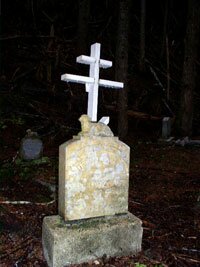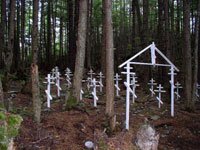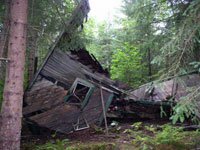
 |
|
||||||||||||||||||||||||
|
America's Territory
The Aleut Evacuation - A Grave Injustice
10-01-1998
 Cemetary commemorating the Aleuts who died while in internment at Funter Bay. Collection Name: Photo taken at Funter Bay, 2004 by Marjorie Menzi  Grave marker of Aleut infant who died at Funter Bay. Collection Name: Photo taken at Funter Bay, 2004 by Marjorie Menzi The communities of St. George and St. Paul also boarded the Delarof, which departed on 18 June 1942. In addition to not being told the destination to which they were headed, the Aleuts were placed in the hold where space was so inadequate it was impossible to separate the sick from the healthy. The government doctor from St. George refused to enter the hold and the sick went untreated. Philemon Tutiakoff recalled that, "None of the questions were answered. We were always referred to someone of a higher rank and then we received the answer that what is happening to you is for your own protection."(10) This pattern of disorganization and deprivation established early in the evacuation would continue for years. Dora Dushkin was six when she, with the rest of her family, boarded a ship for Funter Bay. On board, Dora gained a baby sister, who died shortly after her birth of pneumonia. Susan Della Kochutin was laid to rest in the Gulf of Alaska near Kodiak and was sadly the first casualty of the evacuation. In June and July 1942, 881 Aleuts were removed by the U.S. Government from. nine villages on six islands north and west of Unimak Island--Akutan, Atka, Umnak (Nikolski), St. George and St. Paul.(11) The reason given for the Alaska Native evacuation was to protect the Aleut people from the potential hazard of Japanese attacks. Southeast Alaska was the home for all five of the evacuation camps, which were ill-suited for year-round use. Six days after their departure, 458 Aleuts from St. George and St. Paul debarked in Funter Bay. The St. Paul evacuees were housed in an abandoned fish cannery where they could view, just three miles away, the community of St. George in an old mining camp. An early order of business in the evacuation camps was to establish a chapel.(12) Orthodox communities in southeast Alaska donated religious icons to help furnish the churches, along with the few religious articles the evacuees brought with them. The Aleuts' strong faith in their religion held them together through the trials they were to endure during their three-year displacement. Women and children could be heard singing "Onward Christian Soldiers" to lift their spirits. Deplorable conditions existed in the camps. Some of the wooden buildings were so rotten people actually fell through the floor. Dora Duskin's first memory of Funter Bay was of her family of 12 living in a poorly insulated space that was ten feet by ten feet, partitioned by blankets. Mice and rats scurried across the floor. A toilet over the beach just above the low tide mark served 200 people.(15) AlI the human waste was washed directly into the Bay. The water was contaminated and the facilities for boiling water were hard to come by. Food was scarce and Dora Dushkin and her sisters began chewing on their thumbs to ward off hunger pangs. On 11 July 1942, L.C. McMillin, agent and caretaker of the Pribilof evacuation camp at Funter Bay, wrote the following letter to Edward C. Johnstone, Superintendent of Alaska Fish and Wildlife. "We have as many as ten and thirteen people, large and small, sleeping, or trying to sleep, in one room. The novelty has worn off long ago and now the real growling is commencing in earnest. Most of them have all the reason in the world to complain. No brooms, soap, mops or brushes to keep the place suitable for pigs to sleep in. It seems funny that our government can drop so many people in a place like this and then forget about them altogether."(14). "They had little regard for the people," remembers Anna Philemonoff, whose sister and both grandmothers died during internment. "It was almost like we were unimportant, like our lives didn't matter."(15) N. Berneta Block, M.D., Director of the Division of Maternal and Child Health and Crippled Children's Services, described camp conditions at Funter Bay as follows: "As we entered the first bunkhouse the odor of human excretion and waste was so pungent that I could hardly make the grade. Children were found naked and actually covered with excrete. The garbage cans were over flowing, human excrete was found next to the doors of the cabins and the drainage boxes into which dishwater and kitchen waste was to be placed were filthy beyond description.(16)  Remains of cannery building at Funter Bay. Collection Name: Photo taken at Funter Bay, 2004 by Marjorie Menzi As stated, by Ward T. Bower, Chief of the Division of Alaska Fisheries, U.S. Fish and Wildlife Service, "From the time of the evacuation of these people from the Pribilof Islands upon a few hours notice in June 1942 under order of our armed forces, there have been various discouraging problems in the way of suitable housing, sanitation, medical, school and other facilities, all of which have apparently lowered the morale of almost everyone concerned. There is no excuse for the filth which exists at Funter Bay and this office will insist to the utmost that supervisory field officials have the situation corrected."(19) There was hope for some Aleut children who were sent to Wrangell Institute; a Government School for Natives, located outside of Wrangell, Alaska. A number of the children who stayed in the camps died, some reportedly from pain, others from lack of simple medical care. Flore, an Aleut boy described Wrangell Institute as follows, "When I got to the Institute I was homesick. The students were strangers to me and the trees looked ugly, because I had never seen a tree in all the sixteen years of my life. First, I learned to look after myself. Second, I became acquainted with the students. I was soon very happy."(20) Even though the Aleuts at Wrangell Institute were not exposed as readily to diseases and deplorable living conditions, they went on the ship which took many Natives back to their original homeland to harvest seals. The evacuation was altered in January 1943, by the Secretary of war, to allow the Aleut's to harvest sealskins, a government money-making priority. "Now the agency wants to take these people back to the Pribilofs from which they were evacuated because of the danger. They need these people to kill and skin the seals and to care for the fox, irregardless of the fact that they will be endangering the lives of these people."(21) To persuade the men to return for the 1943 seal harvest, the U.S. Fish and Wildlife Service considered denying return passage to the Pribilofs after the war, and loss of all privileges of island residency.(22) "A meeting was held on 20 March 1943 with the St. Paul Natives, and I believe there will be no trouble in securing enough men to go sealing without using force or making too many promises."(23) The Natives were falsely told that the seals they were killing were going towards the making of army clothing and other accessories to aid the army. The seal skins were sold through the Fouke Fur Company, which made the profits, while the Aleuts worked virtually as unpaid labor. Over ten percent of the Aleuts died during their internment and the rest received scars that they would have to bear, for the rest of their lives. They returned to their communities, nearly two years after the war ended and a year after relocation was approved, as strangers in their own homeland. President Franklin D. Roosevelt, in providing emergency appropriations for resettlement, limited payment of claims for 850 people to no more than $12.00 per person.(24) The Atkans themselves returned to desolation; their homes and church burned to the ground, everything gone. The residents of Akutan and Nikolski found their churches vandalized by U.S. military personnel who had occupied the villages. The distinctive cupola, located atop the church at Nikolski, had been used for target practice, letting water into the ceiling and walls. Looting and vandalism by the American troops was so extensive in the two villages that inquiries were conducted and extensive repairs were attempted by the military after the war. The U.S. government replaced some of the lost furnishings and appliances; the Navy repaired broken windows and doors."(25) On 10 August 1988, public law 100-383 made restitution to the Aleuts for their - years of personal loss by paying the 450 individual survivors $12,000 each and creating a trust fund for communities and churches. The sum of $6.4 million was appropriated for community use; $5 million was for the six communities to use on projects designed particularly to benefit the elderly, students, and cultural preservation and $1.4 million was to compensate for church property lost, damaged or destroyed."(26) After years of debate on the Senate floor S1009, the Civil Liberties Act of 1988, was passed.(27) The government gave monetary reparations and a formal apology for their actions during the world war II Aleut evacuation. The congressionally-appointed Commission on Wartime Reloction and Internment of Civilians released a detailed account of the relocation, terming it a grave injustice spawned by race prejudice, wartime hysteria and a failure of political leadership.(28) The official indifference which so many Native American groups have experienced affected the Aleuts as well. Dora Dushkin stated "It's unbelievable, in this country to have something like that happen to us in our own country, you would think we were the enemy, we were not."(29) "It gives me great pleasure to know I am an Aleut and that I don't have to pretend to be who I am not. We were taught to be strong, truthful and share what we have and some of us are still doing what we can to pass this on to our children and grandchildren. No group of people in must ever go through what we went through, ever, as Americans."(30)" The Aleuts suffered difficult times that no one should have to face ever again. Even though the Aleuts did receive a cash settlement for their suffering it could not completely compensate for the hostility and the conflicts they had to face. More important to the Natives was the apology that the government gave to them. The government was willing to compromise and try to help, by allotting money for the restitution of the Aleuts' communities. Through their spirituality, perseverance and their ability to adapt, the Aleuts made their way through many difficulties. Ultimately they survived, united as a people, the Aleuts of Alaska.
|
||||||||||||||||||
|